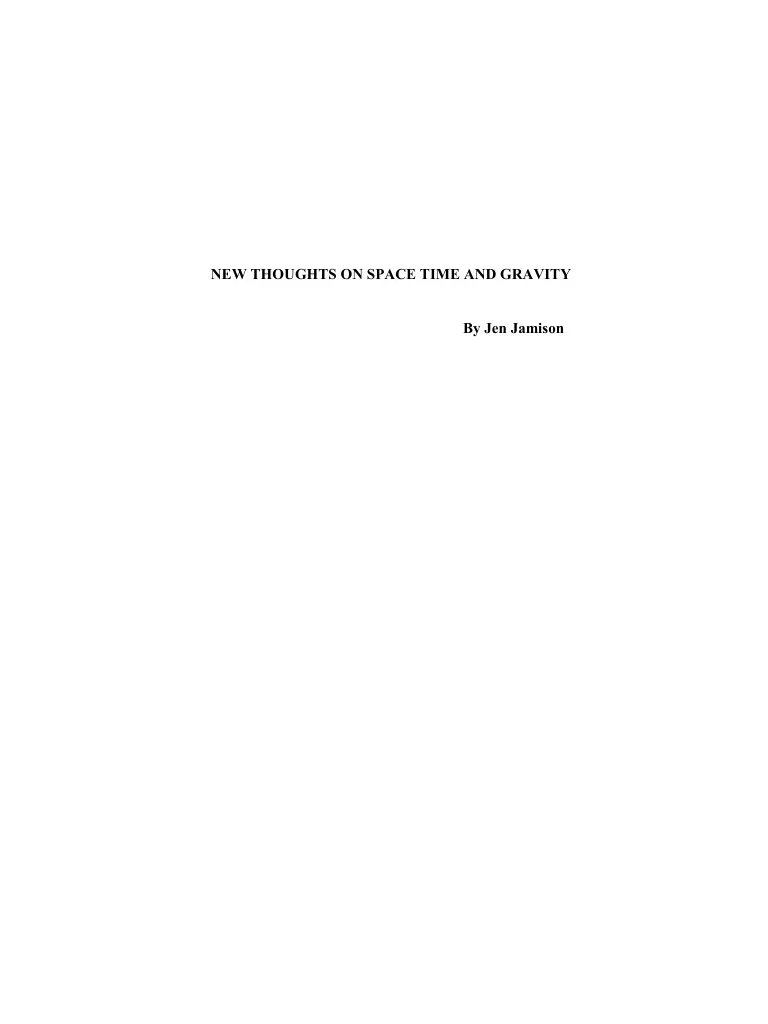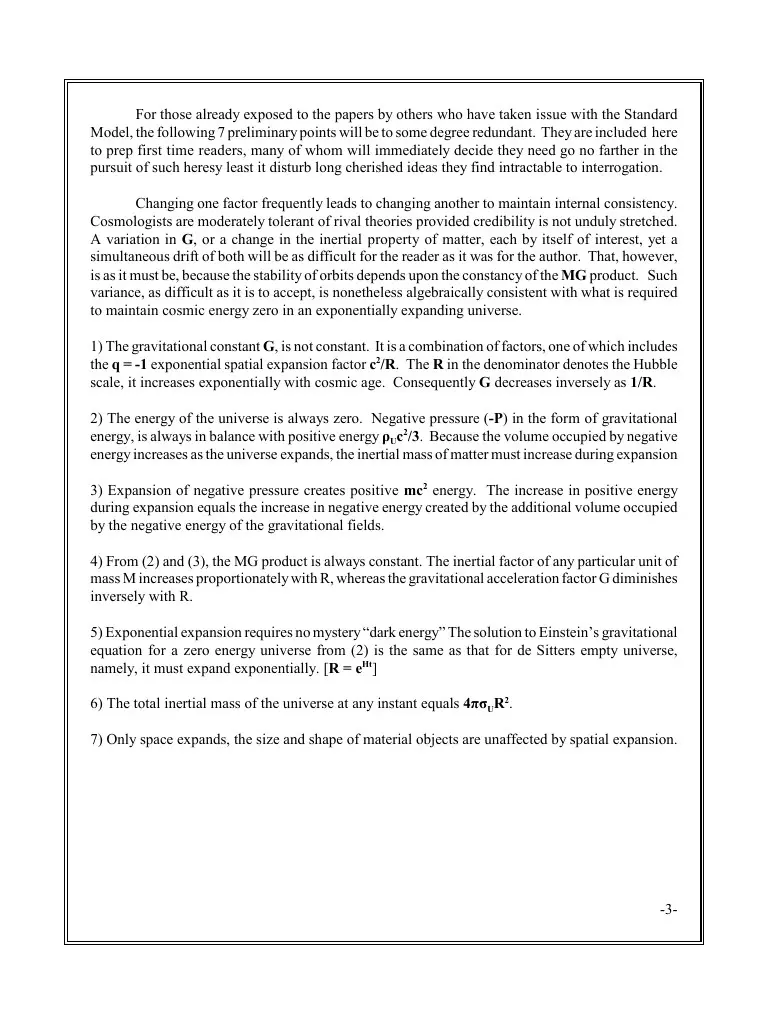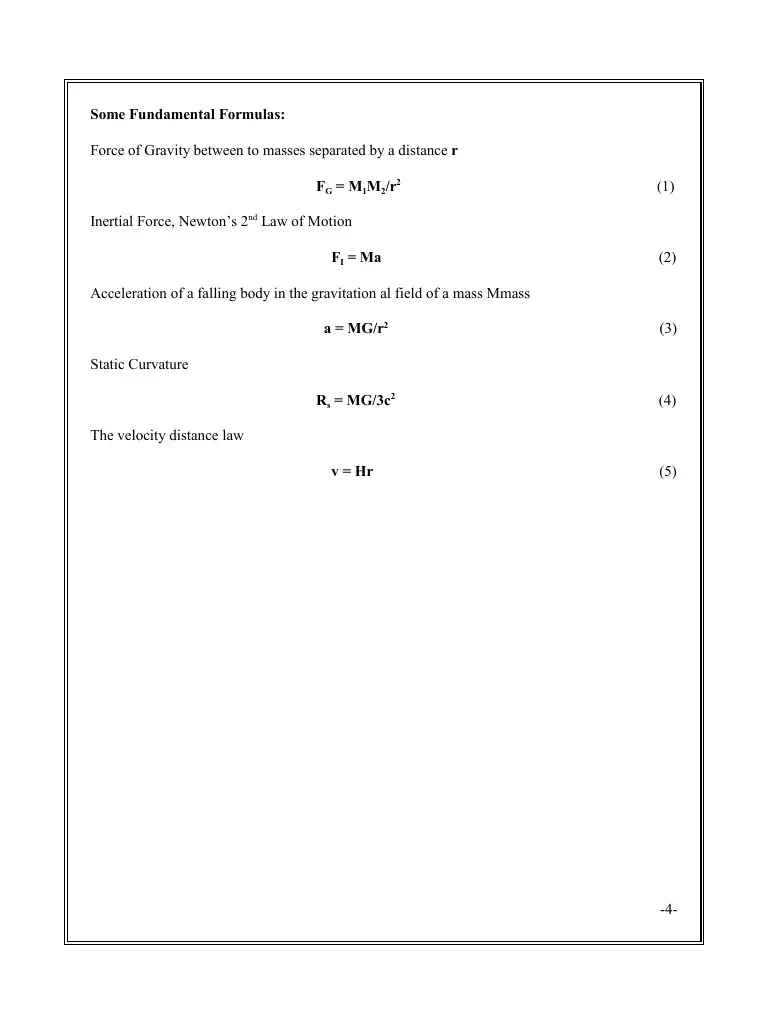NEW THOUGHTS ON SPACE TIME AND GRAVITY, Sept 24, 2016 (PDF)
File information
Title: C:\Users\HP\Documents\NEW THOUGHTS ON SPACE TIME AND GRAVITY.wpd
Author: HP
This PDF 1.3 document has been generated by PrimoPDF http://www.primopdf.com / Nitro PDF PrimoPDF, and has been sent on pdf-archive.com on 22/09/2016 at 02:21, from IP address 99.174.x.x.
The current document download page has been viewed 954 times.
File size: 971.55 KB (33 pages).
Privacy: public file





File preview
NEW THOUGHTS ON SPACE TIME AND GRAVITY
By Jen Jamison
NEW THOUGHTS ON SPACE, TIME AND GRAVITY
In the realm of space, stretched in size from minute to beyond the visible galaxies, all is
ruled, not by the Gods of antiquity, but by the laws of motion. The push and pull of gravitational,
and inertial forces acting between material entities determine the universe and its existence. It is no
wonder then, that humans have invented other material entities, endowed them by hypothesis with
special force transmitting properties, all to purchased peace of mind to the daunting question as to
why spatial separation is not also influential separation?
All things are spatially connected. But how can nothing exert influence. Is it not possible
that the inertia of a body resisting acceleration is in someway communicating the existence of
spatially connected matter throughout the universe? Ernst Mach thought so. How might this happen
within a geometry without bounds, a flat manifold of infinite extent?
The universe is a vacuum, the density ρU of the observable Hubble volume is insignificant.
Yet space communicates F = ma opposition to every accelerating mass. How is it that such a rarified
constitution can bring about forces proportional to the mass content of material bodies? The void
must in some way physiologically exist in a different form, not as a density ρU, but rather a geometry
that mathematically marshals its ingredients to oppose acceleration.
Proceeding in steps, first by transformation of Hubble flow to surface flux, thence then from
2-sphere shell to an infinite plane density σU as the operative geometry of flat space. That the
universe is not limited to the spherical Hubble volume of observation, is already well known. The
Hubble scale, however, is a convenient sample size by which to assess the density of mass confined
by its manifold. The derivation of Newton’s 2nd law in terms of its cosmological origin, reveals
gravity to be but a reactionary force scaled by the surface density of the infinite plane.
Cause for puzzlement arises from the revelation that the ratio of Hubble mass to Hubble area
is approximately one/kgm per square meter. That it is exactly 1 kgm/m2 makes one wonder if the
universe is a: “put up job” (to quote Fred Hoyle). The reality is, of course, that those following after
Newton’s discovery of the 2nd Law, had the prerogative of defining reactive force as one “ntn” per
kgm if acceleration is one meter per second squared. In doing so they were unknowingly making a
statement about the operative density of the infinite plane that defines the mechanics of space.
From the infinite plane, gravitational force follows straightaway. ‘g’ fields of local bodies
are none other than “pseudo forces” as first suggested by Richard Feynman. The formulation follows
from Gauss’s law of gravity. Having determined the universe communicates reactance as an infinite
plane of surface density σU, then by analogous reasoning, the mass of any uniform spherical object
“Me”can likewise be transformed to a surface density σe. The gravity field of Me is then obtained
straightaway by recognizing the pressure created by exponential expansion flux an acting upon σe
must equal the pseudo force acceleration ‘g’ acting back upon the cosmic density field σU of the
universe. That is:
g(σU) = (σe)an
That local ‘g’ fields can be calculated without using Newton’s gravitational constant G,
would indicate something is wrong. In actuality, G encodes the cosmological acceleration factor
c2/R, so all is well in the above, should one desire to read the rest of the story.
-2-
For those already exposed to the papers by others who have taken issue with the Standard
Model, the following 7 preliminary points will be to some degree redundant. They are included here
to prep first time readers, many of whom will immediately decide they need go no farther in the
pursuit of such heresy least it disturb long cherished ideas they find intractable to interrogation.
Changing one factor frequently leads to changing another to maintain internal consistency.
Cosmologists are moderately tolerant of rival theories provided credibility is not unduly stretched.
A variation in G, or a change in the inertial property of matter, each by itself of interest, yet a
simultaneous drift of both will be as difficult for the reader as it was for the author. That, however,
is as it must be, because the stability of orbits depends upon the constancy of the MG product. Such
variance, as difficult as it is to accept, is nonetheless algebraically consistent with what is required
to maintain cosmic energy zero in an exponentially expanding universe.
1) The gravitational constant G, is not constant. It is a combination of factors, one of which includes
the q = -1 exponential spatial expansion factor c2/R. The R in the denominator denotes the Hubble
scale, it increases exponentially with cosmic age. Consequently G decreases inversely as 1/R.
2) The energy of the universe is always zero. Negative pressure (-P) in the form of gravitational
energy, is always in balance with positive energy ρUc2/3. Because the volume occupied by negative
energy increases as the universe expands, the inertial mass of matter must increase during expansion
3) Expansion of negative pressure creates positive mc2 energy. The increase in positive energy
during expansion equals the increase in negative energy created by the additional volume occupied
by the negative energy of the gravitational fields.
4) From (2) and (3), the MG product is always constant. The inertial factor of any particular unit of
mass M increases proportionately with R, whereas the gravitational acceleration factor G diminishes
inversely with R.
5) Exponential expansion requires no mystery “dark energy” The solution to Einstein’s gravitational
equation for a zero energy universe from (2) is the same as that for de Sitters empty universe,
namely, it must expand exponentially. [R = eHt]
6) The total inertial mass of the universe at any instant equals 4πσUR2.
7) Only space expands, the size and shape of material objects are unaffected by spatial expansion.
-3-
Some Fundamental Formulas:
Force of Gravity between to masses separated by a distance r
FG = M1M2/r2
(1)
Inertial Force, Newton’s 2nd Law of Motion
FI = Ma
(2)
Acceleration of a falling body in the gravitation al field of a mass Mmass
a = MG/r2
(3)
Rs = MG/3c2
(4)
v = Hr
(5)
Static Curvature
The velocity distance law
-4-
The Runaway Universe
If the Hubble constant H is truly constant, then change in velocity is proportional to velocity,
that is, since v = HR, then:
dv/dt = H(dr/dt) + r(dH/dt)
(6)
For H constant the second term is zero and therefore (6) reduces to
&&r
r&
(7)
r = eHt
(8)
H=
Which has solution (Appendix 5)
Solution (8) was not accepted as fact until the 1a supernova studies were initiated near the
end of the 20th Century. Starting in the infinite past, expansion would appear to increase gradually,
a tentative conclusion which at first look appears to teach away from the idea of a hot dense early
era upon which nuclear synthesis is predicated. The exponential beginning however, need not start
with time independent growth of space from zero volume. Whatever be the true initial conditions,
the rate of change of volume (and consequently stress) will be inversely proportional to size.
While concern here is not with beginnings, but rather the “now” state of the universe, prior
conditions need to be addressed to explain how the universe arrived at its present condition. In this
regard, a successful theory of space should accommodate what is established as a hot dense earlier
phase that accounts for the observed ratios of elements. The usual development of particles from
space-time interaction, assumes the pace of space defined by c(dt) = ds where spatial growth is
slaved to the passage of time. Constant temporal rate produces constant ‘c’ velocity expansion. But,
if expansion depends from natures law of geometric growth, the quantity of existing space will
determine the production of new space. This is the essence of the velocity-distance law v = Hr.
Since H is 1/τ where τ is the Hubble time, the scale factor ‘r’ specifies as:
(9)
r = v(τ)
In a universe where space and time are interdependent, then t = 1/H = r/c. Identifying ‘a’
with what is believed to be the present rate of cosmological acceleration [q = ( -1)], then:1
S=
∫
dS =
∫
at(dt) =
c2 r
∫ r c dt =
∫
c(dt)
(10)
The scale ‘S’ increases linearly with time. But because the rate of passage of time increases as space
dilates, growth is exponential. This leads to the curious result that‘r’ appears to have a root about
14 billion years past. Even though the exponentially expanding universe is in theory, past eternal,
when ‘r’ is plotted against uniform time, it displays the countenance of a beginning.
1
Where q is the misnamed deceleration parameter now used to specify the cosmological acceleration rate in
terms of the expansion parameters of the Hubble sphere discussed infra.
-5-
The Hubble Inertial Field
It is known that a body B accelerated with respect to the void experiences a reactionary force
administered by the universe. It is Newton’s expression of this Principle as his 2nd law of motion that
sets the stage for the zero energy universe and the unification of gravity with spatial expansion:
F = d/dt(mv) = m(dv/dt) + v(dm/dt)
(11)
To formulaize (11) as a cosmological reaction using the realm of the Hubble sphere as a cosmic
sample size for determining average density, then for a body of constant mass M, (11) reduces to:
Force
M
=
[a] = Pressure
2
meter
meter 2
(12)
where both sides of Newton’s 2nd law have been divided by one square meter area. The reactionary
force density is dimensionally equivalent to “pressure” which for empty space equates to virtual
momentum flow. If the value of the intensity expressed by the left side of (12) is of cosmological
origin, then the reactive pressure opposing acceleration of internal matter, should be expressible in
terms of Hubble parameters. Since the right side of (12) is formulated as an accelerated scalar
surface density, the cosmic counter force can likewise be defined by the same units. The magnitude
of the reaction however, will depend upon how the inertial and spatial properties of the Hubble
combine to oppose changing velocity of internal matter. Provisionally, the Hubble scalar density is
taken as the bare mass-energy MU divided by the Hubble area AH, whence
MU
M
a 2 = σ U a 2 = B2 (a 1 ) = σ B a 1
AH
m
(13)
where a2 is the cosmological counter acceleration required to balance (a1) for a fixed value of σU.
Invoking then, Einstein’s principle of relative acceleration, specifically if a body ‘B’ is maintained
at rest in a unidirectional accelerating universe ‘U’ having a rate a2 equal to a1, the body B would
experience a force (MB)a2 identical to MBa1. To calibrate the cosmos let a1 equal one meter per
second squared, and MB equal one kgm, then σU must equal one kgm/meter2.
[One kgm/m2 ][meter/sec2] = one ntn/m2 = σU
(14)
In this special case where unidirectional spatial acceleration (a2) replaces a local impetus a1 acting
directly upon B, Einstein’s doctrine of relative acceleration requires the forces {and consequently
momentum flow(s) defined by the pressure} be equal. While the acceleration a2 will have different
values for different masses and different accelerations, the ratio σU = MU/AH = 1 kgm/m2 will remain
constant for all manner of masses and accelerations. The ratio MU over AH is the Sigma surface
density of the Hubble. Unlike local volumetric density ρ, because of homogeneity on the large scale,
the infinite flat plane density σU will have the same operative value throughout.
-6-
Mach’s Principle Reinstated
While (14) is structured in terms of mass per unit area, the reactionary force is independent
of size, shape, volume and distribution of matter because pressure is, in reality, momentum flow.2
A one kgm mass accelerated at a1 provokes an equal counter reaction a2 if the sigma density factor
σU = MU/AH = 1 kgm/m2. That reactionary acceleration a2 equals a1 when σU = σB, permits σU to be
scaled per (14) with reference thereto. Once σU is known for a particular mass MB = one kgm
accelerating at one meter per second squared, it is known for all accelerations and masses. To
expose the Hubble universe as a reactive surface density, the mass/volume ratio has been taken as
the sample size, from which the scalar surface density σU deciphers as the inertial operative3 With
this revelation, Mach’s Principle is reinstated as the predicate upon which inertial reactance is
hinged—not as a modifier of the individual value of masses, but rather as the essence of the global
reactive force, common as in denominator, to all inertial and gravitational phenomena.
2
Following Newton’s discovery of the inertial dependence of force upon the ‘ma’ product, the ‘Newton’
was established as the unit of force per kgm equaling “one-meter-per-second-squared. The tie between mass, force
and acceleration is not dependent upon size or volume, but in the context of pressure as momentum flow, space is an
essential part of nature’s formulation(s). The spatial dimensionality is overlooked because it cancels on both sides of
the equation to the consternation of humans endeavoring over many years to understand inertia? The concept of
momentum flow as pressure transcends the pedestrian view of pressure as a surface phenomena. Momentum flow is
integrally tied to the smallest units of matter - each individual constituent of elemental mass is in some way defined
by a volume, and all space is expanding. While each elemental mass constitutes a volume, collectively the amount of
space occupied by a large number of small masses will depend upon how they are bound. However, the size of the
physical structure like the size of an atom, is not influenced by expansion.
3
That the rarified volumetric density of universe (ρU . 10-26 km/m3) manifests as one kgm/meter2 surface
density in opposing internal accelerations, is a ratification of an abstraction first proposed by Bishop Berkeley in the
18th Century, later credited to the 19th Century physicist, Ernst Mach, as Mach’s Principle. The σU factor in the
denominator of (14) incorporates the entire Hubble mass MU (approximately 1.5 x 1053 kgm) – but because it is
spread uniformly over the effective area, the functional effect of Hubble mass as a participant in the formulation of
inertia is relegated to a unity operative σU = kgm/m2. Mach’s principle is alive (better stated as revived), inasmuch
as it does not modify m. The surface density function slumbers in the denominator, moderated by the area over
which it is spread – its presence necessary to explain inertia and gravity, yet having no effect upon any numerical
value involving m (energy mc2, momentum mv, reaction ma, weight mg and potential mgh). The one kgm/m2 scalar
density factor is not fortuitous. When the 17th century experimenters following Newton’s discovery of the 2nd Law,
made measurements to relate force and mass to acceleration, they were actually measuring the global properties of
the universe. One ntn per kgm = one meter per second squared.
-7-
Transformation of Hubble Energy to Infinite Plane
Both Mach and Einstein rejected the idea of inertia as a sovereign property of the mass
undergoing acceleration. But to admit a cosmological source within the predicate of Mach’s
Principle, was an effrontery to the theory of Special Relativity. Herein, the issue of how space
instantaneously communicates the presence of other matter is addressed by double transformation
from 3-sphere —> 2-sphere —> infinite plane as depicted in Figure 2. In the 1st transformation a
fully homogenized 3-D Hubble sphere is transformed to a 2-sphere. The ensuing gravitational
energy deficit is redressed by reducing the 2-sphere radius R2 by 5/6. In the 2nd transformation, the
2-sphere is transformed to a flat plane, resulting in a gravitational energy deficit of 50%. For present
purposes, Hubble scale R3 will be provisionally taken as 1.3 x 1026 meters, the mass Mu as 1.5 x 1053
kgm. The effective radius R2 for the infinite plane is then aprox 1.1 x 1026 meters
Uniform Density Hubble
3-Sphere with G energy
U3 = [3(Mu)2][G/5R3]
Transformation of 3- D
sphere to 2-sphere with no
energy change reduces R2
2-sphere transformation to
infinite flat plane reduces
gravitational energy 50%
FIGURE 2
Physically, the Hubble is 3-D, but operatively it is a surface density σU rather than a volume
density ρU. Intuitively, one might reason the transformation from 2-sphere to infinite plane could
be carried out by simply setting R2 –> 4 (Assuming new volume adds mass proportionately, so
density remains constant). But alas, that is not the way the world is made -- the force produced by
an infinite plane is half that produced by the infinitely large 2-sphere geometry.4
4
The infinite 2-sphere and infinite plane are mathematically different geometries. Half of 2-sphere energy
is in the form of gravitational binding, which is lost when transforming from 2-sphere to infinite plane (Appendix 3).
-8-
Inertial Field Produced By Infinite Plane
The gravitational force on a unit mass at a point P produced by a large sheet of material (Fig 3), will
be directed toward the sheet. Let the distance of the point from the sheet be ‘a’ , and let the amount
of mass per unit area of this large sheet be ‘µ’ which is premised to be constant. What field dC is
produced by the mass dm lying between ρ and ρ+dρ from the point O of the sheet nearest point P?
Answer: dC = - G(dmr/r3). But this field is directed along r, and only the ‘x’ component
will remain when all the vectors dC are added to produce C. The x component of dC is:
dCx = ! G(dm)rx/r3 = ! G(dm)a/r3
All masses dm which are at the same distance r from P will yield the same dCx, so we may at once
write for dm the total mass in the ring between ρ and ρ+dρ, namely dm = µ(2π)ρdρ
(2πρdρ is the area of a ring of radius ρ and width dρ, if dρ n ρ). Thus
dCx = ! Gµ2πρdρa/r3
Then, since r2 = ρ2 + a2, ρdρ = rdr. Therefore,
Cx = !2πGµa I dr/r 2 = 2πGµa(1/a !1/4
4) = 2πGµ.
(15)
Thus the force is independent of distance ‘a.’ One might think that the farther away, the weaker the
force. But no! If P is close, most of the matter is pulling at an obtuse angle; if far away, more matter
is situated favorably to exert a pull toward the plane. At any distance, the matter which is most
effective lies in a certain cone. When farther away force is smaller by the inverse square, but in the
same cone, in the same angle, there is more matter, by the square of the distance.
-9-
Download NEW THOUGHTS ON SPACE TIME AND GRAVITY, Sept 24, 2016
NEW THOUGHTS ON SPACE TIME AND GRAVITY, Sept 24, 2016.pdf (PDF, 971.55 KB)
Download PDF
Share this file on social networks
Link to this page
Permanent link
Use the permanent link to the download page to share your document on Facebook, Twitter, LinkedIn, or directly with a contact by e-Mail, Messenger, Whatsapp, Line..
Short link
Use the short link to share your document on Twitter or by text message (SMS)
HTML Code
Copy the following HTML code to share your document on a Website or Blog
QR Code to this page

This file has been shared publicly by a user of PDF Archive.
Document ID: 0000485687.